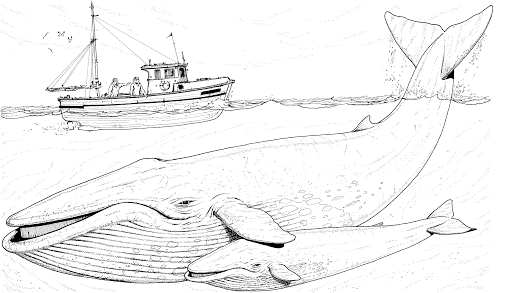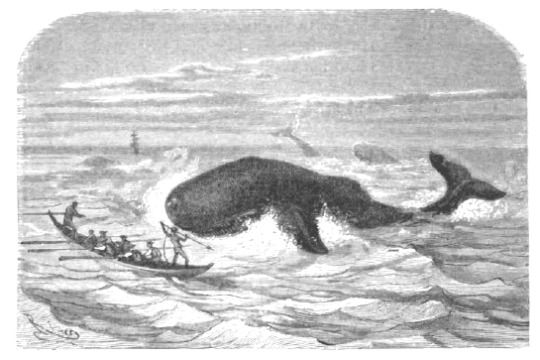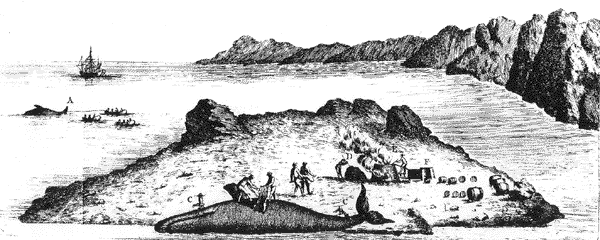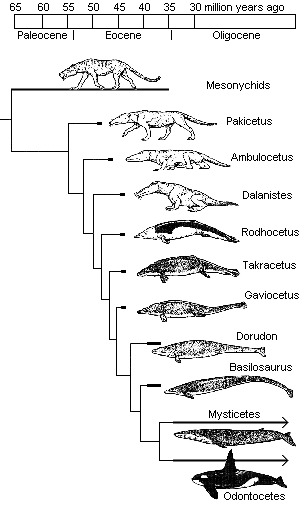Text
Endangered, to what extent?
In 1986, a moratorium was implemented by the International Whaling Commission to stop commercial whaling completely, separate from subsistence whaling or cultural traditions, and help endangered whale populations recover. However, commercial whaling still persist today and the fight against commercial whaling has yet to end. Japan, Iceland, and Norway all continue to hunt whales and governments benefit from the loopholes or even turn a blind eye to the slaughter. Whaling has had a severe effect and some species may never recover. In the United States, the number of North Atlantic right whale is down to 350. The blue whales of the Antarctic are at less than 1% of their original number. West Pacific grey whale are on the edge of extinction with about only 100 remaining. In addition to having experience global warming, ocean acidification, noise pollution and ship strikes, overfishing also threatens their food supply and whales are constantly entangled in fishing nets every year.
List:
1. North Atlantic Right Whale - Critically Endangered
2. North Pacific Right Whale - Endangered
3. Sei Whale - Endangered
4. Blue Whale - Endangered
5. Western Gray Whale - Endangered
6. Vaquita - Critically Endangered
7. Narrow-Ridged Finless Porpoise - Endangered
8. Baiji - Critically Endangered (Possibly Extinct)
9. Atlantic Humpback Dolphin - Critically Endangered
10. Hector's Dolphin - Endangered
0 notes
Quote
How can we save the whales?
talk about it, continue the dialogue, reach out to organisations, sign petitions, spread awareness
0 notes
Photo
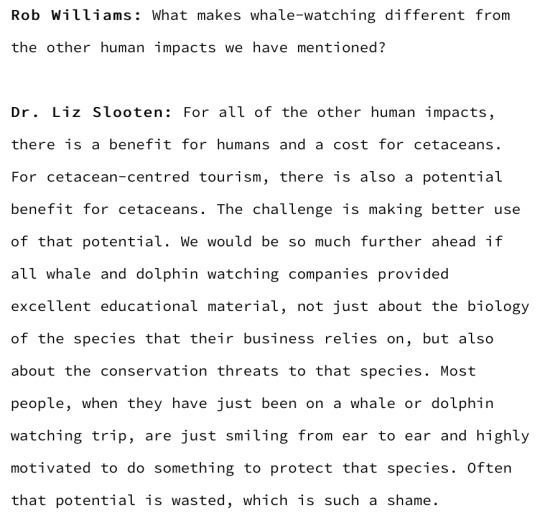
A short excerpt from “Threats facing cetaceans population, global context” by Rob Williams
0 notes
Text
An Inuit tradition
The Inuit’s way of whaling is different from commercial whaling in that the people engage in the activity primarily for sustenance. They have lived on Nunangat (the land, water, and ice), and more specifically the Arctic regions of Canada, Greenland, Alaska, and Russia, for thousands of years. Their traditions are based on sharing, co-operation, respect for the land, animals, and each other. Whales hunted by the Inuit communities have always serve as spiritual symbols, which contrasts greatly with the more contemporary methods of whaling. There would be rituals prior to the hunting, charms and amulets hung off the belts of the people in the boat or put at the bottom of the boat, and fresh drinks of water would be offered to the whales as a way to offer thanks. To the Inuit, hunting is more than about killing but it is a sacred act. The men may harpoon and do the heavy work but the women are the ones who attract the whales to give themselves up. Furthermore, the whales would also be stored in the earth so that their souls could go back into the earth more easily. Beautiful things are associated with the whaling activities and shows how whaling differ quite greatly from place to place.
0 notes
Quote
Cultures are dynamic and fluid; they change and transform according to internal and external forces, adaptations, and the introduction of new ideas, skills, knowledge, and technologies. However, non-native society has consistently attempted to lock native society and culture into a specific time.
Charlotte Coté, Spirits of our Whaling Ancestors
0 notes
Text
Basque Whalers
The first commercial whalers hunted right and bowhead whales off the coast of Spain and France in the 11th century. Prior to the development of industrial equipments, whalers engaged in shore whaling, which is basically a kind of mechanism where whales are attached through a harpoon or spear to slow them down, exhausting them to the point where they can be finished. It is quite remarkable that the whalers began with small boats of 6 to 9 people but later developed into a big enterprise, expanding their operations to the Strait of Belle Isle waters by the island of Newfoundland and Labrador coast. Between the 16th and 17th century, Basque whalers from France and Spain launched at least 15 ships (that averaged around 700 tons) with 600 men per season. The most famous station at Red Bay, Labrador was named after the colour of the butchering. A lot of money was made and this was the beginning of commercial whaling. Furthermore, details regarding the responsibilities of the owner and those that supplied the material and equipments were established before the ship set sail. A contract would identify members and listed the obligations and the powers of the owner. It included information about the crew, wages, meals, etc., and divided the products obtained from the voyage. Normally, the owner received a quarter, the crew acquired a third, and the outfitter (the ones responsible for supplying the equipment) secured the remainder.
0 notes
Quote
There is, one knows not what sweet mystery about this sea, whose gently awful stirrings seem to speak of some hidden soul beneath...
Herman Melville, Moby-Dick
0 notes
Text
As apex predator...
Killer whales are at the top. The food chain is greatly dependent on apex predators in order to maintain a healthy and stable ecosystem. Killer whales are distributed throughout the world’s oceans and their diets range from penguins to salmon and even great white sharks, securing their position as top marine predators. Killer whales have never attacked humans in the wild as we are not a part of their diet but there is one well-known case of a them killing people when held in captive. Tilikum suffered great psychological stress from having to spend its life performing at SeaWorld and was the cause of three deaths. This shows how important it is for whales to be in their natural habitat instead of being held in captive by humans.
0 notes
Photo
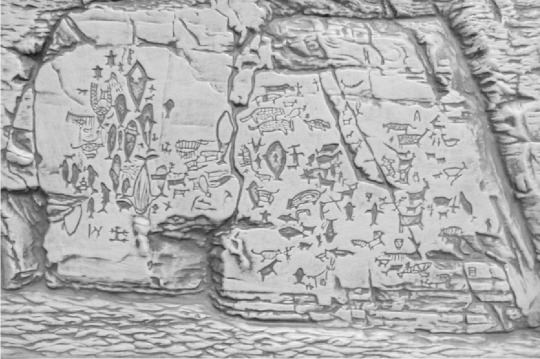
The prehistoric Bangudae Petroglyph in Ulsan, Korean.
66 notes
·
View notes
Text
Whales used to walk.
Whales appeared 50 million years ago, following the extinction of dinosaurs but prior to the appearance of humans. The earlier theory suggested that whales were related to the mesonychids, an extinct order of carnivorous ungulates (hoofed animals) but more recent research suggest that whales are actually more closely related to the artiodactyls, specifically the hippopotamus. Though both hippos and whales are large and aquatic, they have evidently evolved separately and formed different characteristics from each other. The Pakicetus, the earliest proto-whales, were actually land animals. The Ambulocetus came afterwards and lived a more aquatic lifestyle as indicated by their shortened legs and enlarged paddle-shaped feet and hands. Saltwater and freshwater have different levels of oxygen isotopes and scientists use this information to understand their migration. Whales that evolved after the Ambulocetus, such as the Basilosaurus, had even higher levels of saltwater oxygen isotopes in their bones and teeth, suggesting that they lived in marine habitats similar to today’s whales. Throughout the whole process, the skeletal structure of the whales evolved into a more streamlined shape in order to adapt to their more aquatic lifestyle. The nostrils evolved further and further back into the snout and this trend continued to living whales, giving the “blowholes” located on the top of the head and above the eyes that we see today. These changes may seem slow and gradual but accumulate to show the impressiveness of evolution.
0 notes
Text
There are two types of whales?
Indeed! Toothed whales are torpedo shaped, have a bulbous head and long beaks. They have conical shaped teeth and primarily feed on fish and squid. The “melon” on their foreheads emanate clicks that bounce off structures. This is known as echolocation and is also seen in bats. They don’t have a strong sense of smell or taste but at least they have a unique way of navigating the ocean. The sperm whale, the beluga, the narwhal, and the oceanic dolphins are some examples of toothed whales but there are actually 76 species altogether grouped into 10 families.
Baleen whales, on the other hand, don’t have teeth but have filtered plates made of keratin instead. Keratin is a material similar to our fingernails and hair. To feed, they lunge into the water and then push all the water out of the baleen (their teeth) where the krill would consequently get caught. It is rather interesting that the blue whale is the biggest animal on earth yet feed on the smallest animals in the ocean. Although they don’t echolocate, they do sing and moan to communicate with each other. There are four families of baleen whales with approximately 14 species but this number is still debated among scientists.
0 notes
Photo
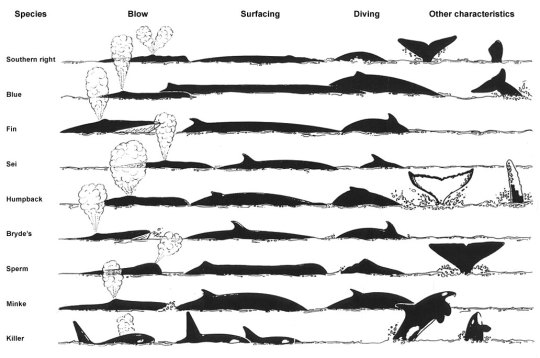
The following characteristics are often used to identify and classify whales:
- body length
- presence of a dorsal fin
- size and position of the dorsal
- fin shape and size of flippers
- shape of the head and general body shape
- presence of a beak
- shape of the blow
- body colour and patterns
- swimming characteristics
- presence of teeth or baleen
- number of teeth
0 notes
Text
Six Quick Facts
The blue whale is the biggest animal on earth, ranging between 82 and 105 feet and weighing about 200 tons.
Bowhead whales can live for more than 200 years.
Whales can sing but we’re not really sure why.
Humpback whales live off their blubber for 5.5 to 7.5 months and therefore actually don’t eat most of the year.
Most think that sharks are the ocean���s apex predator, but it is actually the killer whales.
0 notes
